
How to Use SparkFun Soil Moisture Sensor: Examples, Pinouts, and Specs
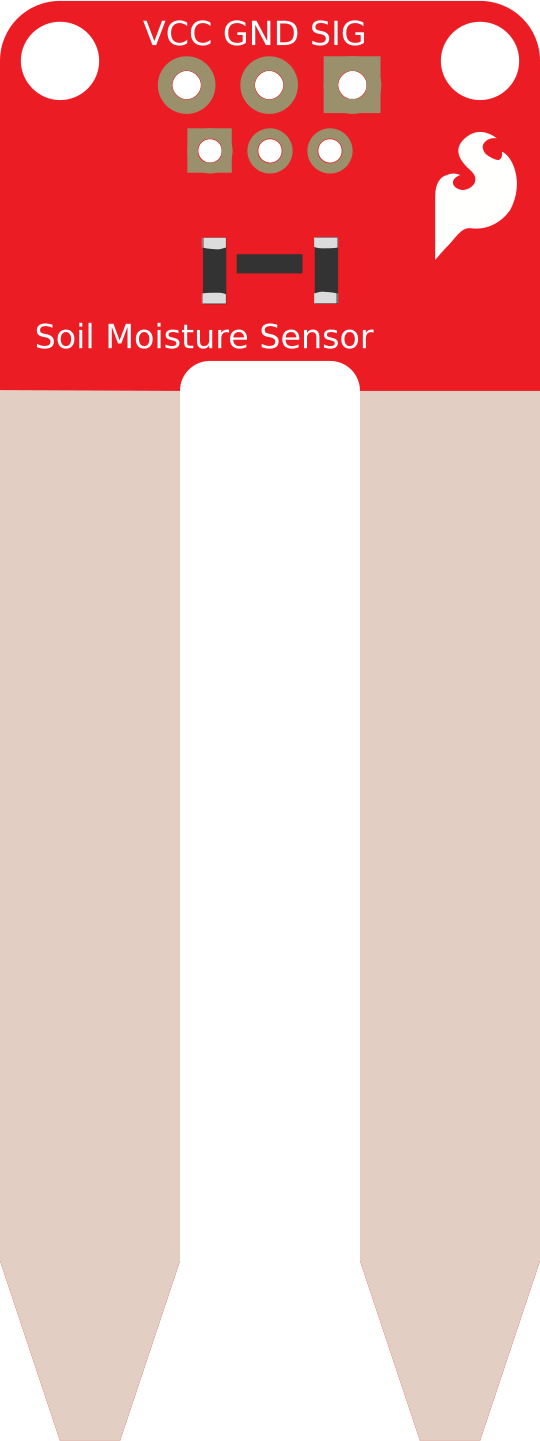
 Design with SparkFun Soil Moisture Sensor in Cirkit Designer
Design with SparkFun Soil Moisture Sensor in Cirkit DesignerIntroduction
The SparkFun Soil Moisture Sensor is a device designed to measure the volumetric water content in soil. It provides an analog output that corresponds to the moisture level, making it an essential tool for applications such as precision agriculture, gardening automation, and environmental monitoring. By integrating this sensor into a system, users can monitor soil conditions and optimize irrigation schedules, ensuring efficient water usage and healthier plants.
Explore Projects Built with SparkFun Soil Moisture Sensor
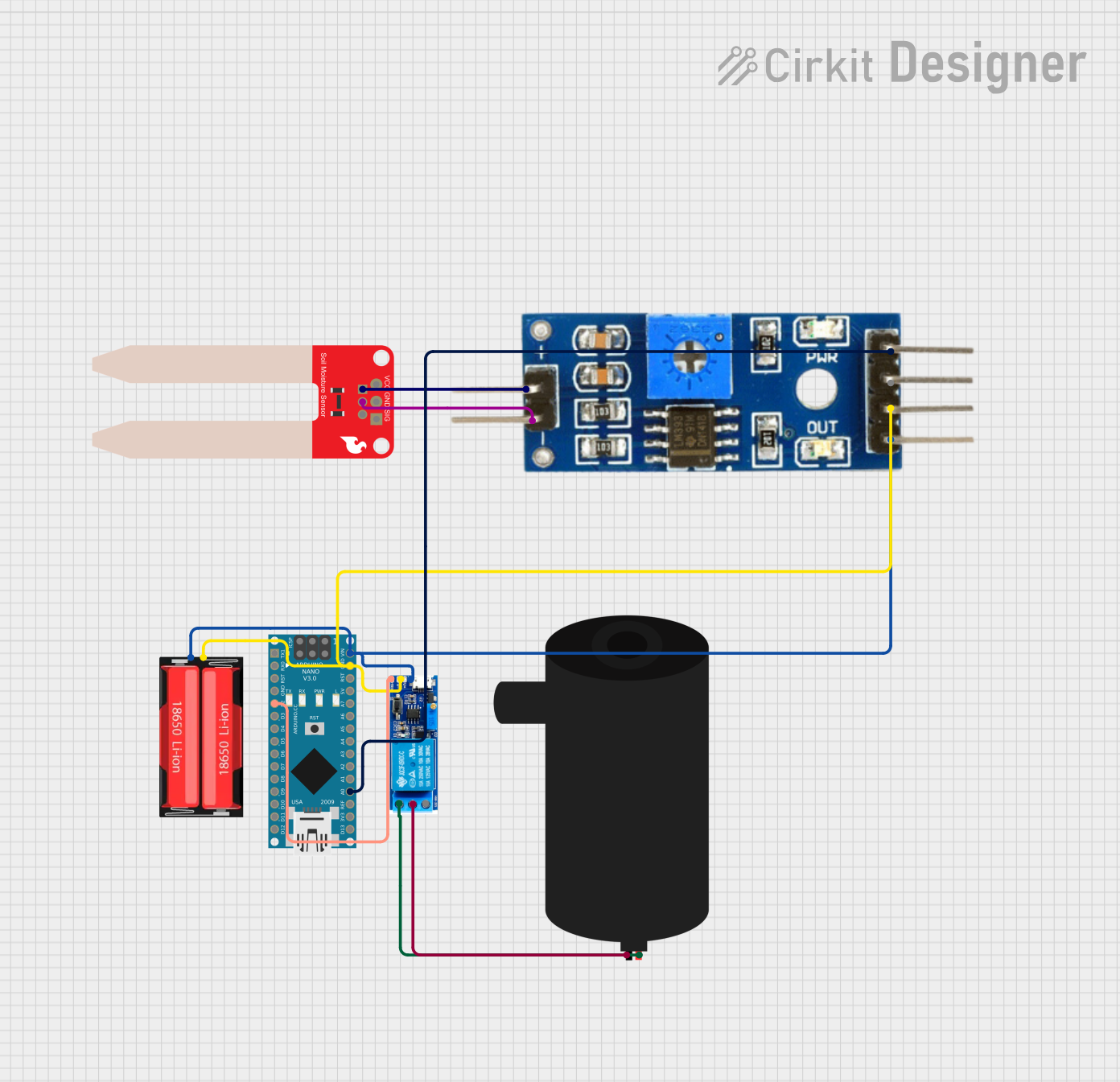
 Open Project in Cirkit Designer
Open Project in Cirkit Designer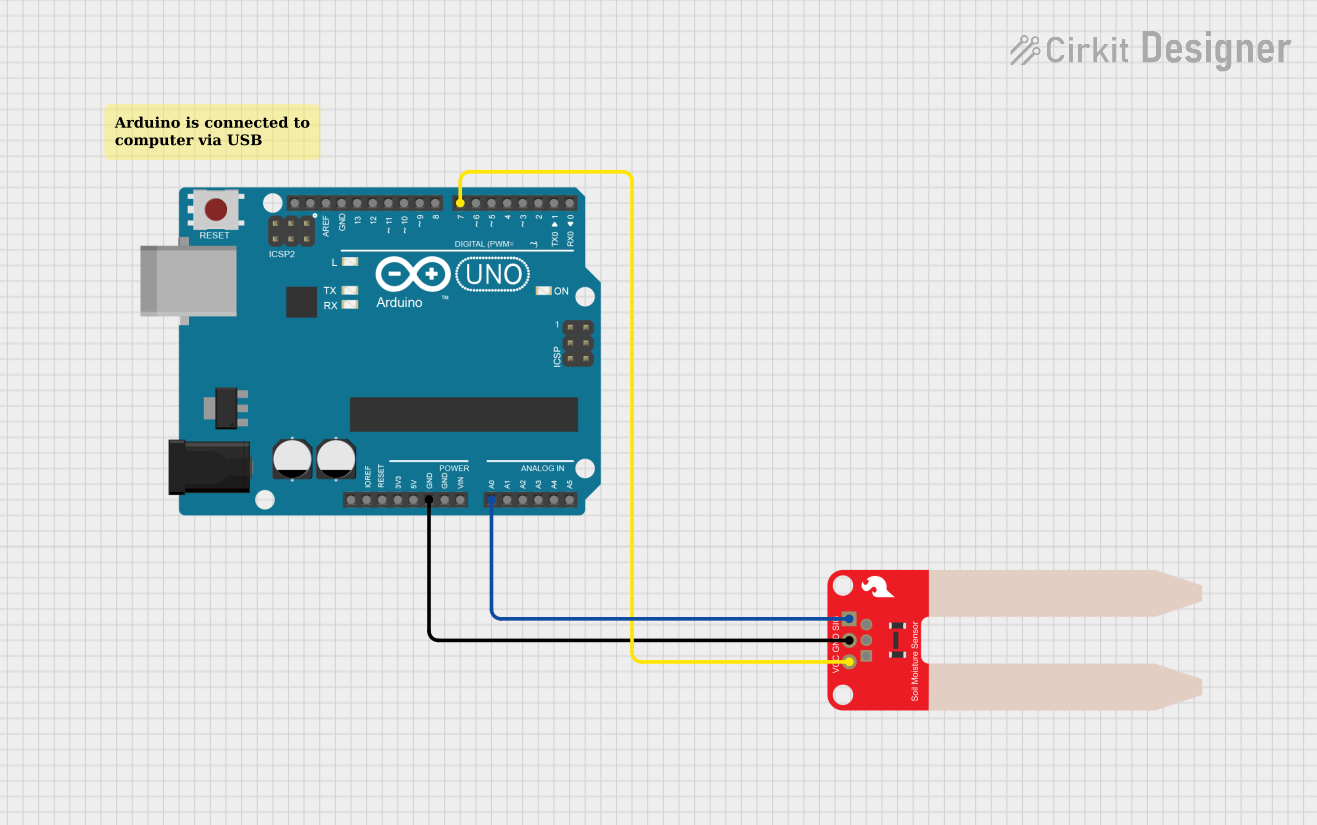
 Open Project in Cirkit Designer
Open Project in Cirkit Designer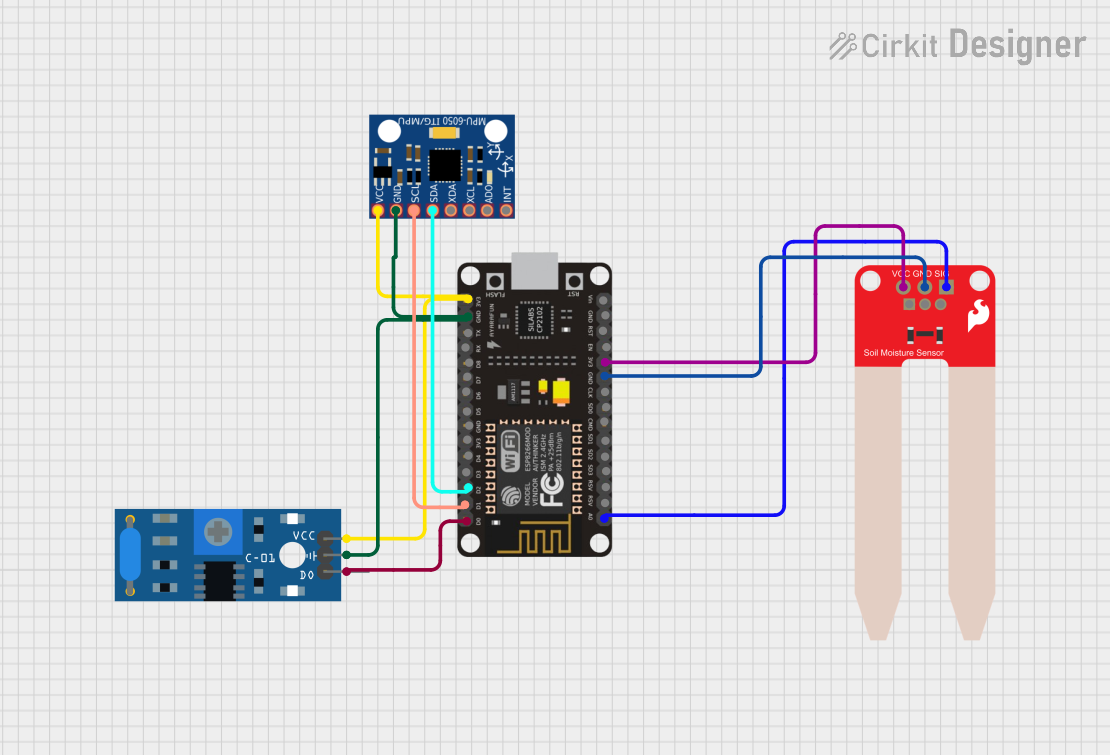
 Open Project in Cirkit Designer
Open Project in Cirkit Designer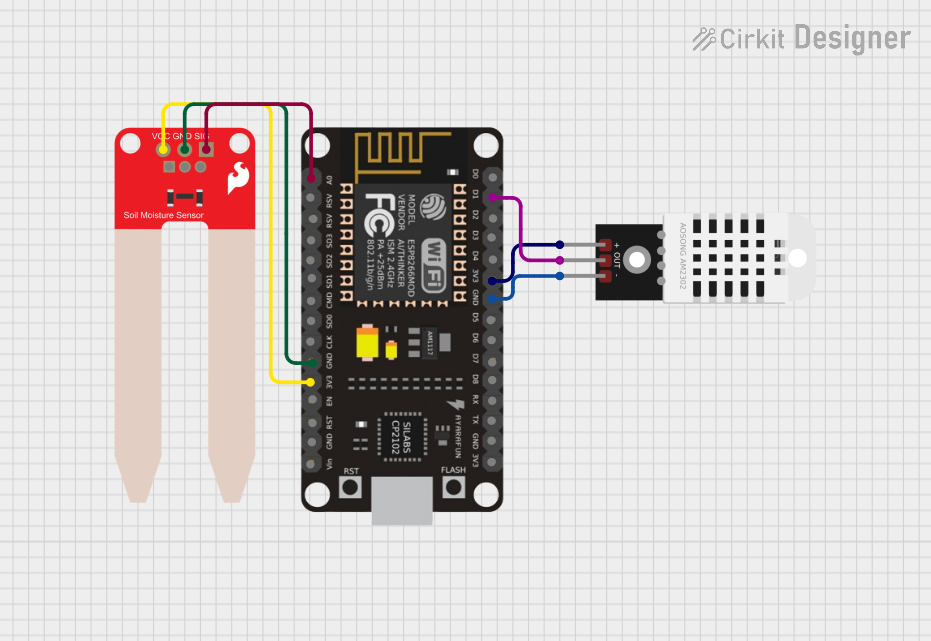
 Open Project in Cirkit Designer
Open Project in Cirkit DesignerExplore Projects Built with SparkFun Soil Moisture Sensor

 Open Project in Cirkit Designer
Open Project in Cirkit Designer
 Open Project in Cirkit Designer
Open Project in Cirkit Designer
 Open Project in Cirkit Designer
Open Project in Cirkit Designer
 Open Project in Cirkit Designer
Open Project in Cirkit DesignerCommon Applications and Use Cases
- Automated irrigation systems for gardens and farms
- Soil monitoring in greenhouses
- Environmental research and data collection
- Smart gardening projects using microcontrollers like Arduino or Raspberry Pi
Technical Specifications
The SparkFun Soil Moisture Sensor is a simple yet effective tool for measuring soil moisture. Below are its key technical details:
| Parameter | Specification |
|---|---|
| Operating Voltage | 3.3V - 5V |
| Output Signal | Analog voltage (proportional to soil moisture) |
| Current Consumption | ~20mA |
| Dimensions | 60mm x 20mm |
| Interface Type | Analog |
| Operating Temperature | 0°C to 50°C |
Pin Configuration and Descriptions
The SparkFun Soil Moisture Sensor has three pins, as described in the table below:
| Pin | Name | Description |
|---|---|---|
| 1 | VCC | Power supply pin. Connect to 3.3V or 5V from the microcontroller or power source. |
| 2 | GND | Ground pin. Connect to the ground of the circuit. |
| 3 | SIG | Analog signal output. Provides a voltage proportional to the soil moisture level. |
Usage Instructions
How to Use the Sensor in a Circuit
Wiring the Sensor:
- Connect the
VCCpin of the sensor to the 3.3V or 5V pin of your microcontroller. - Connect the
GNDpin of the sensor to the ground (GND) of your circuit. - Connect the
SIGpin to an analog input pin on your microcontroller (e.g., A0 on an Arduino UNO).
- Connect the
Placement:
- Insert the sensor prongs into the soil at the desired depth. Ensure the prongs are fully in contact with the soil for accurate readings.
- Avoid placing the sensor in waterlogged soil for extended periods, as this may cause corrosion.
Reading the Output:
- The sensor outputs an analog voltage that varies with soil moisture:
- Dry soil: Higher voltage (closer to VCC).
- Wet soil: Lower voltage (closer to GND).
- The sensor outputs an analog voltage that varies with soil moisture:
Important Considerations and Best Practices
- Corrosion Prevention: The sensor's prongs are prone to corrosion over time, especially in wet conditions. To extend the sensor's lifespan, avoid continuous exposure to water and consider using a protective coating on the prongs.
- Calibration: For accurate results, calibrate the sensor by measuring the output voltage in both dry and wet soil conditions. Use these values to map the sensor's output to specific moisture levels.
- Power Supply: Ensure the sensor is powered within its operating voltage range (3.3V - 5V). Exceeding this range may damage the sensor.
Example Code for Arduino UNO
Below is an example of how to use the SparkFun Soil Moisture Sensor with an Arduino UNO:
// SparkFun Soil Moisture Sensor Example Code
// This code reads the analog output from the sensor and prints the moisture level
// to the Serial Monitor.
const int sensorPin = A0; // Analog pin connected to the sensor's SIG pin
int sensorValue = 0; // Variable to store the sensor reading
void setup() {
Serial.begin(9600); // Initialize serial communication at 9600 baud
pinMode(sensorPin, INPUT); // Set the sensor pin as an input
}
void loop() {
// Read the analog value from the sensor
sensorValue = analogRead(sensorPin);
// Print the sensor value to the Serial Monitor
Serial.print("Soil Moisture Level: ");
Serial.println(sensorValue);
// Add a delay to avoid flooding the Serial Monitor
delay(1000); // Wait for 1 second
}
Interpreting the Output
- The
analogRead()function returns a value between 0 and 1023, corresponding to the sensor's output voltage. - You can map these values to a percentage or specific moisture levels based on your calibration.
Troubleshooting and FAQs
Common Issues and Solutions
No Output or Incorrect Readings:
- Cause: Loose or incorrect wiring.
- Solution: Double-check all connections, ensuring the
VCC,GND, andSIGpins are properly connected.
Fluctuating Readings:
- Cause: Poor contact between the sensor prongs and soil.
- Solution: Ensure the sensor is firmly inserted into the soil. Avoid rocky or loose soil.
Corrosion of Prongs:
- Cause: Prolonged exposure to water or high humidity.
- Solution: Use a protective coating (e.g., nail polish or conformal coating) on the prongs to reduce corrosion.
Sensor Not Responding:
- Cause: Exceeding the operating voltage range.
- Solution: Verify that the power supply voltage is within the 3.3V - 5V range.
FAQs
Q1: Can the sensor be used in hydroponic systems?
A1: The sensor is designed for soil use. While it can measure moisture in some hydroponic setups, prolonged exposure to water may accelerate corrosion.
Q2: How do I calibrate the sensor?
A2: Measure the sensor's output voltage in completely dry soil and fully saturated soil. Use these values to create a mapping function for your application.
Q3: Can I use the sensor with a Raspberry Pi?
A3: Yes, but since the Raspberry Pi lacks analog input pins, you will need an external ADC (Analog-to-Digital Converter) to read the sensor's output.
Q4: What is the lifespan of the sensor?
A4: The lifespan depends on usage and environmental conditions. Proper care, such as avoiding prolonged exposure to water and using protective coatings, can extend its life.
By following this documentation, you can effectively integrate the SparkFun Soil Moisture Sensor into your projects and ensure reliable performance.